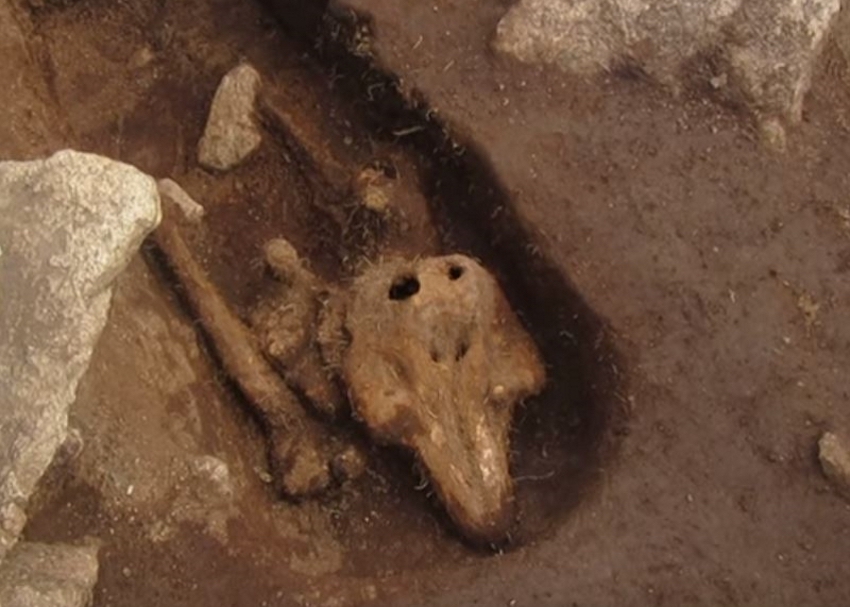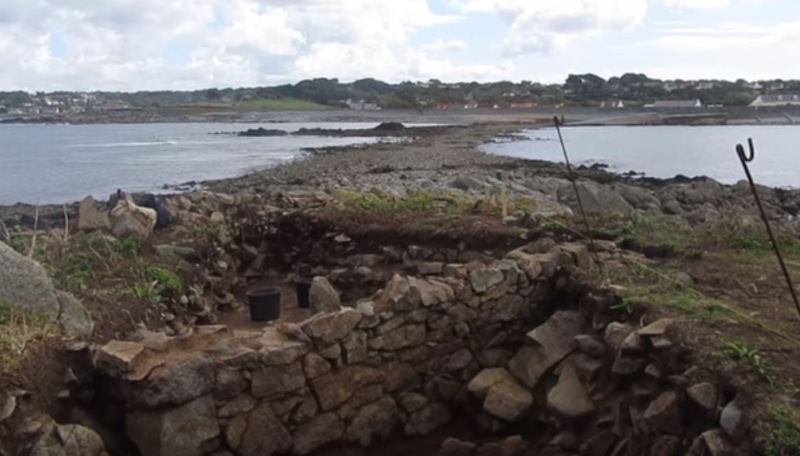Surprise Find: Dolphin Bones Unearthed in Medieval Island 'Grave'

Archaeologists excavating a medieval site on a tiny islet in the English Channel were baffled by the discovery of a dolphin skeleton in what appears to be a carefully prepared grave.
The researchers first thought they had discovered a human grave, cut into the bedrock of the islet of Chapelle Dom Hue, about 900 feet (300 meters) off the west coast of Guernsey, one of the largest Channel Islands. Instead, the researchers were astonished to find that the grave held the skull and bones of a sea mammal, now thought to be a dolphin, but originally identified as a smaller porpoise, said archaeologist Philip de Jersey, who led the dig this month.
Both types of sea mammal were found in the waters around Guernsey during the Middle Ages, he said. [The 25 Most Mysterious Archaeological Finds on Earth]
"The big puzzle from an archaeological point of view is that it really does look like a grave cut for a human — exactly like we would find in a medieval cemetery," De Jersey told Live Science. "So, it was a bit of a surprise to start excavating it and find a sea creature in there instead."
De Jersey added that he hasn't heard of any similar archaeological findings, saying, "It’s just a strange thing to do, and it would have taken a lot of effort."
Islet of mystery
The dolphin remains were found in the last few days of a three-week excavation of Chapelle Dom Hue by De Jersey and his colleagues from the States of Guernsey archaeology team.
The rocky islet measures only about 49 feet (15 meters) across. It can be reached from the Guernsey mainland by an isthmus most of the time, but it is cut off for a few hours each day at high tide, De Jersey said.
Get the world’s most fascinating discoveries delivered straight to your inbox.
Based on the name of the islet and fragments of pottery found during the excavation, the researchers said they think that a stone building that once stood on the island may have been used as a religious retreat or shrine by Christian monks during the 14th century.
The dolphin bones are the only remains, animal or human, that were found during the excavations, De Jersey said.
"The thing that I have a problem with is why they've gone to so much care to cut this pit or grave, because it has been cut right down into the bedrock," he said. "And they've done it carefully — the pit has a nice, flat base to it, and it's taken really considerable effort to cut this pit into the ground. But then why put a [dolphin] into it, when you could just dump those sort of remains in the sea?"
Salted dolphin
Although dolphins often appear in historical sources as a Christian symbol, De Jersey said he has not learned of any other cases in which dolphins were buried in Christian graves.
"I don't know any parallels to this in the study of medieval cemeteries," he said. "Putting an animal like this in there is just unheard of really, so perhaps that all points to it not being a grave."
Another possibility is that the animal was butchered for food, then packed with salt as a form of preservation and buried in the pit, he said.
"There is literary evidence from the 13th and 14th centuries which mentions that porpoise was definitely eaten at that time," De Jersey said.
"And the implication is that it wasn't eaten fresh, so there must have been some way to preserve it, by drying it or salting it in some way," he added. "So, we've wondered whether this was a pit filled with salt, and they've put the animal in, and for whatever reason, it was never retrieved."
De Jersey said it's possible that an analysis of the soil surrounding the dolphin remains may reveal additional clues.
The arrangement of bones in the grave also suggested that the animal may have been butchered before it was placed in the pit, he said.
Now that the excavations on Chapelle Dom Hue have come to an end, the next stage in solving the mystery will be to determine the age of the bones with radiocarbon dating, to test the soil it was found in and to verify the species of the animal, De Jersey said.
"We will get expert advice when we've got the bones cleaned up, and I hope someone will be able to say exactly what it is," he said.
Original article on Live Science.
Tom Metcalfe is a freelance journalist and regular Live Science contributor who is based in London in the United Kingdom. Tom writes mainly about science, space, archaeology, the Earth and the oceans. He has also written for the BBC, NBC News, National Geographic, Scientific American, Air & Space, and many others.




